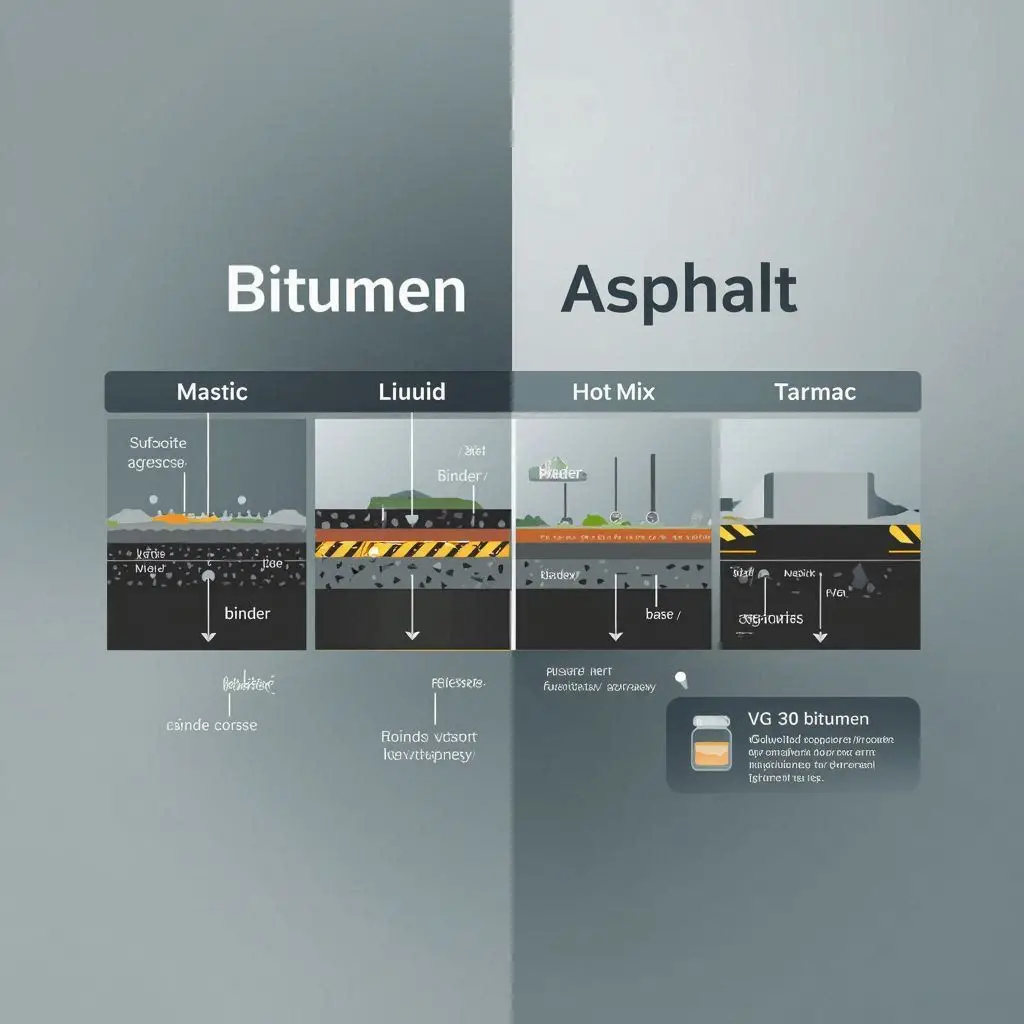
Asphalt vs Bitumen: Mastic, Liquid, Hot Mix & Tarmac Differences Explained
In the fields of road construction and maintenance, distinguishing between asphalt and bitumen is a key consideration. This guide explains the differences between asphalt, bitumen, mastic, liquid mixes, and tarmac while referencing VG 30 bitumen for practical applications.
ASPHALT VS BITUMEN
The comparison between asphalt and bitumen is common in paving discussions. Bitumen functions as the binding agent, derived from petroleum, whereas asphalt is the composite result of mixing bitumen with mineral aggregates like sand and crushed rock.
VG 30 bitumen is widely used in road surfacing due to its excellent viscosity and binding strength. It is particularly suitable for moderate traffic conditions, making it a preferred choice for durable asphalt mixtures. Asphalt, on the other hand, provides the structural layer for roads, highways, and parking lots.
SEO Snippet: Asphalt vs bitumen highlights the distinction between the binder (bitumen) and the composite mixture (asphalt), with VG 30 bitumen being a standard choice for long-lasting roads.
MASTIC ASPHALT VS BITUMEN
Flexibility and durability are key points in the mastic asphalt versus bitumen debate. Mastic asphalt is formulated as a thick blend of bitumen, mineral fillers, and finely graded aggregates. It is heated and applied as a molten liquid, creating a seamless and waterproof surface ideal for roofing, flooring, and bridge decks.
Bitumen alone, especially VG 30 grade, does not provide the same ready-to-use structure. While VG 30 bitumen offers a strong binding agent, it requires aggregate blending to form mastic asphalt. With its outstanding skid-resistant surface, mastic asphalt is a preferred choice for areas frequently used by pedestrians.
SEO Snippet: Mastic asphalt vs bitumen shows that mastic is a prepared mix offering high durability, while bitumen is the raw binder like VG 30 used to produce the mix.
LIQUID ASPHALT VS BITUMEN
Liquid asphalt and bitumen differ primarily in their state and application techniques. Liquid asphalt is a bitumen-based material modified with solvents or emulsifiers to remain fluid at lower temperatures. It is primarily used for road repairs, seal coating, and surface dressing.
Bitumen, such as VG 30, typically solidifies at ambient temperature and requires heating before application. Liquid asphalt eliminates this heating step, making it more convenient for patchwork or small-scale applications. However, VG 30 bitumen is more common in large-scale paving projects due to its strength and performance under heavy loads.
SEO Snippet: Liquid asphalt vs bitumen highlights liquid mixes’ convenience, while VG 30 bitumen is preferred for structural, high-performance paving.
HOT MIX ASPHALT VS BITUMEN
Hot mix asphalt vs bitumen focuses on temperature and composition. Hot mix asphalt is produced by blending heated aggregates with bitumen at high temperatures, creating a strong and durable paving layer. Because of its durability, this mix is suited for high-load areas like highways and runways. Bitumen by itself is unsuitable for top layers, but when VG 30 is used in hot mix asphalt, it enhances elasticity and adhesion, helping the pavement endure both temperature extremes and heavy use.
SEO Snippet: While VG 30 bitumen acts as the essential binder, hot mix asphalt is the end product ready for paving — this distinction defines the comparison.
ASPHALT VS BITUMEN VS TARMAC
Asphalt vs bitumen vs tarmac comparisons often arise in construction terminology. Tarmac, originally developed using tar, is now outdated and rarely used. Bitumen-based asphalt has taken its place, offering superior longevity and environmental benefits.
VG 30 bitumen provides far better weather resistance and durability than tar, making it a superior choice. Asphalt roads using VG 30 bitumen can last decades with proper maintenance, unlike tarmac, which is more prone to cracking and wear.
SEO Snippet: Asphalt vs bitumen vs tarmac shows that modern asphalt with VG 30 bitumen is more durable and eco-friendly compared to traditional tar-based surfaces.
CONCLUSION
Understanding asphalt vs bitumen is vital for selecting the right material in road construction and industrial applications. While bitumen like VG 30 acts as a binding agent, asphalt is the final surfacing mix. Mastic asphalt, liquid asphalt, and hot mix asphalt each serve unique functions in construction, in contrast to tarmac, which is largely phased out in current infrastructure practices.
SEO Snippet: Asphalt vs bitumen comparisons reveal that VG 30 bitumen plays a critical role in modern, long-lasting road surfaces.
FREQUENTLY ASKED QUESTIONS (FAQs)
1. What distinguishes asphalt from bitumen in terms of composition and use?
The main difference between asphalt and bitumen is that bitumen is the binder, while asphalt is the final paving mixture. Bitumen is a black, sticky petroleum derivative (like VG 30) used to bind aggregates, while asphalt is the composite material made by mixing bitumen with crushed stone, sand, and gravel.
2. What are the key reasons for the widespread use of VG 30 bitumen in roadworks?
VG 30 bitumen is preferred for moderate to heavy traffic roads because of its excellent viscosity, durability, and weather resistance. It maintains flexibility across a range of temperatures and provides strong bonding in hot mix asphalt applications, reducing the chances of cracking or rutting.
3. Is mastic asphalt more durable than regular asphalt?
Yes, mastic asphalt is often more durable and waterproof than traditional asphalt. It is especially useful in roofing, bridge decks, and industrial flooring, where impermeability and skid resistance are critical. However, it is more expensive and used for niche applications compared to regular asphalt roads using VG 30 bitumen.
4. Can liquid asphalt be used for full road construction?
No, liquid asphalt is primarily used for patching, sealing, and surface treatments, not for full structural paving. It’s made by blending bitumen with emulsifiers or solvents to remain workable at lower temperatures. For durable road base layers, VG 30 bitumen is commonly used in combination with hot mix asphalt.
5. Is tarmac obsolete in today’s construction industry?
Indeed, tarmac has largely been replaced by more advanced surfacing materials. Bitumen-based asphalt, especially that made with VG 30, is now the go-to option due to its superior performance and eco-friendliness compared to tar-bound tarmac.

